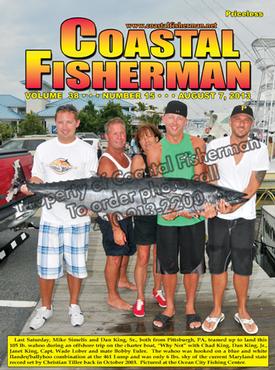


Article by Capt. Monty Hawkins
 In the early 1980s I often heard, "We'll never see marlin again, the blue water's gone." Catch & release of billfish was just taking serious hold back then. Old timers thought it was too little—too late. They thought that no matter what course billfish conservation took, we'd soon see the demise of marlin anyway because of water quality.
In the early 1980s I often heard, "We'll never see marlin again, the blue water's gone." Catch & release of billfish was just taking serious hold back then. Old timers thought it was too little—too late. They thought that no matter what course billfish conservation took, we'd soon see the demise of marlin anyway because of water quality.
It is true that before the Ocean City Inlet was cut, before 1934, fishers in surf-launched boats would dread seeing marlin rise behind their bluefish baits. They hated to have their gear destroyed. We must have had clear water as little as 3 miles out.
It is true that from the 1940’s to the 1970’s stories abound of white marlin being caught even 5 miles out, of Marlin Club tournaments won with fish caught at the Bass Grounds only 8 miles from the shoreline. There was a time when the Jackspot was a destination, even for boats fishing from New Jersey. It was a time when Ocean City truly earned the title, "White Marlin Capital of the World."
A sight feeder, marlin have been driven much further to sea in ever worsening water - water growing greener & greener. No one north of Hatteras, NC sees billfish roaming nearshore waters these days.
But, it's fixable.
No fishery restoration will ever come by renewing a single habitat component. There will always be multiple considerations. Still, many fisheries, perhaps every fishery, would benefit from increased water quality.
At a 3-day course on fisheries science last winter, Dr. Jon Hare made note of the difference between sea heights above & below the Gulf Stream. As measured by satellite, the ocean is one meter higher on the north side of the Gulf Stream. That heavy Gulf current rolls off North Carolina's Cape and dams the lower Mid-Atlantic. The Labrador current comes slow, cold and south inshore. Those ice melt waters meet the Delaware & Chesapeake Bay's nutrient enriched outflows where Phytoplankton thrive and Algae Bloom. That's where green water and dead zones come from. That's why over the course of 40 years, marlin have been driven from famous nearshore shoals, where they often fed on sand eels and inshore spawning squid, to now the canyons edge & beyond.
Ecosystem Based Fishery Management is just beginning to take shape. In it, scientists and managers look for couplings such as striped bass/menhaden. Championed by both angler & environmental groups, progress is being made.
You can believe that the benthic/pelagic coupling most in need of repair for billfish restoration back to nearshore waters is the oyster. Oyster reef restoration is vital.
Numerous regulations are now in place to restore water quality in our major estuaries. Everything from buffer zones & storm water management to upgrades at sewage treatment plants is being employed. However, the well-recognized 99% decline in the estuaries' primary natural water filter is singularly important: Oysters feed on algae.
When algae blooms thrive, they make pea green water. When they die, they create oxygen-free dead zones.
Estuarine hardbottom reef restoration is vital to restoring billfish. It’s a pretty big leap, but it is true.
I think restoring blue water is as simple as rolling rocks off a barge — a lot of rocks.
The opposition to re-reefing is powerful and has a century of practice. You could snag a gillnet on a real oyster reef and it would stop a dredge cold.
Oyster sanctuaries must only use shell as reef substrate. Not even reef balls are allowed. Why? Because shell dredges well. We've been using shell as a substrate since just after the Civil War. Indeed, Maryland has dedicated serious effort to oyster repletion with shell since the 1920’s. Yet oyster shell has not restored a single oyster reef — not one!
The ocean is turning green. Its time to quit playing with shell. Three dimensional habitat, such as boulders, is key.
We must get enormous oyster reefs functioning in their full ecosystem role again before we see a turn in marine water quality.
Huge reefs will generate huge spat-sets and watermen will find a way to benefit.
Filtering green water restores blue water and blue would be good. Every species in the Mid-Atlantic would benefit.
Capt. Monty Hawkins is captain of the head boat, “Morning Star” that is docked at the Ocean City Fishing Center.